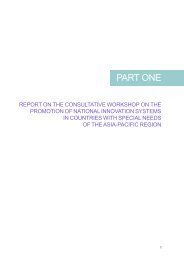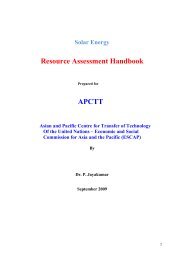Download Complete PDF - apctt
Download Complete PDF - apctt
Download Complete PDF - apctt
- No tags were found...
Create successful ePaper yourself
Turn your PDF publications into a flip-book with our unique Google optimized e-Paper software.
IORGANIZATION OF THE WORKSHOPA. BackgroundAccording to the International Energy Agency (IEA), in 2006, fossil fuels accounted forabout 67 per cent of the primary energy used to generate electricity. The rise in theuse of fossil fuels for power generation has brought with it an increase in greenhousegases (GHG), such as carbon dioxide (CO 2) and nitrogen oxides (NOx), released tothe environment. It is estimated that burning of fossil fuel has caused about 75 percent of the GHG emissions in the last two decades. Following combustion, all of thecarbon contained in the fossil fuels end up as CO 2, the predominant GHG. The negativeimpact of GHG emissions on the environment, particularly on global warming andclimate change, resulting from the steep increase in fossil fuel-based power generationis alarming. With no international agreement to replace the failed Kyoto Protocol onreduction of GHG emissions, electricity generation from fossil fuels is expected toexpand in most developed economies. In the rapidly developing economies, particularlythe largest ones such as China and India, the demand for electricity is expected torise even faster than in the mature industrial economies. A significant part of thisdemand would be met by fossil fuel-generated power. A projection by the World EnergyOutlook 2010 says that world CO 2emissions from fuel combustion will continue togrow, reaching 35.4 Gigatonnes (Gt) CO 2by 2035.In 2009, 43 per cent of CO 2emissions from fuel combustion were produced from coal,says the IEA report CO 2Emissions from Fuel Combustion, 37 per cent from oil and 20per cent from gas. Coal consumption in Asia for power generation stood at an estimated2.7 billion metric tonnes in 2011. This figure is expected to rise to 4.4 billion tonnesannually from 2012 to 2020, according to a research report from New York-based GBIResearch. By 2020, China alone will produce 4.5 billion tonnes of coal annually, reflectinga 3.5 per cent compounded annual growth rate (CAGR) over the coming eight years,the report states. By the same year, India is projected to produce 1.1 billion tonnes ofcoal annually, up from 632 million tonnes of coal in 2011. Such robust growth wouldplace India on par with the United States in terms of total production, assuming internationalmarkets for United States coal remain strong, the GBI Research report adds.In view of the growing economy combined with growing population, India’s powergeneration capacity – 186,655 Megawatts (MW) as on 31 December 2011 accordingto the Central Electricity Authority (CEA) – may have to double in a decade. Coalbasedpower plants account for more than two-thirds of India’s electricity production,and would continue to play a major role in power generation, considering the country’ssizeable deposits of coal and its growing demand for energy. India’s annual rate ofgrowth of power capacity is among the highest in the world, comparable only to China,and is projected to be mostly fossil fuel-based. With nearly 40 per cent of the populationnot having access to grid-fed electricity and the annual per capita electricity consumptionat around 800 kilowatt-hours (kWh), compared with the world average of nearly fourtimes this figure, a massive expansion of power sector is a necessity for inclusivegrowth.In this scenario, adoption of technologies that would ensure emission reduction infossil fuel-based power plants becomes critical. Clean coal technologies (CCT) are2







